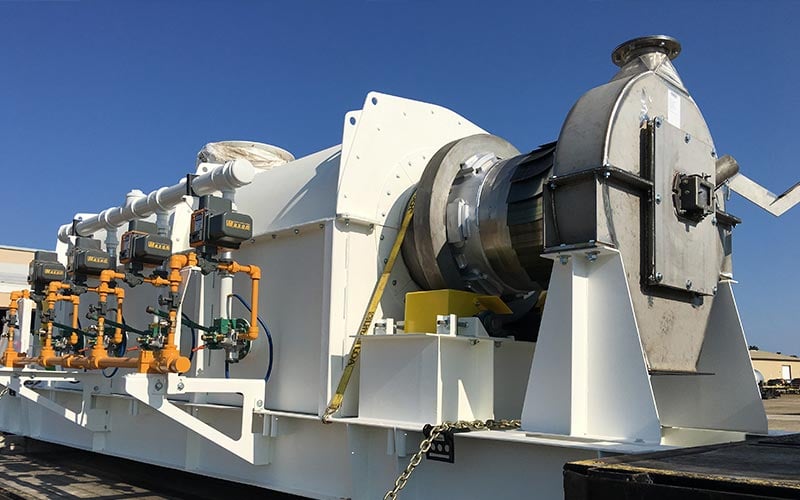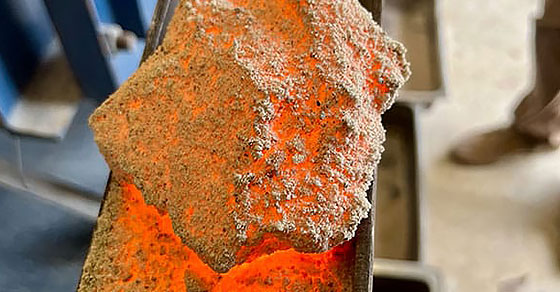A mass and energy balance, also known as a heat and mass balance (HMB), is a critical step in the rotary kiln design process. Unbeknownst to many, however, it can provide significant value beyond the design process as well, helping buyers to estimate operating costs, anticipate maintenance needs, and plan for many other essential aspects associated with building a rotary kiln plant.
The information below covers the basics on this key procedure and how it provides value to both manufacturers and system buyers.
What is a Mass and Energy Balance?
Part of the front end engineering design (FEED) for any thermal process, the mass and energy balance lays the engineering groundwork for equipment sizing and energy requirements by quantifying the flow of mass and energy and showing where and at what temperatures reactions and heat losses occur.
Developed using a series of calculations, the balance takes various aspects of the material and process into consideration, including combustion, heat transfer, chemical reactions, and material phase changes.
By performing a heat and mass balance, engineers are able to theoretically determine several key criteria of the system:
- The amount of heat entering and exiting the kiln
- Temperature profiles throughout the process
- The composition of material at different stages and temperatures of the process
- The energy required to reach each stage of reaction
How the Energy and Mass Balance Informs Kiln Design
By establishing fundamentals such as the energy required, the amount of heat entering and exiting the kiln, etc., engineers are able to size the rotary kiln for optimal performance and efficiency, ultimately minimizing fuel consumption, reducing emissions, and ensuring the appropriate reaction conditions are maintained throughout the process.
The energy and mass balance informs on several aspects of kiln design:
Kiln Sizing and Geometry
The heat and material flow requirements help engineers to determine the appropriate size and geometry for efficient processing in the kiln.
Air Flow Configuration (Co-Current or Counter-Current)
The balance also guides the air flow configuration, or whether the kiln will be designed for co-current or counter-current flow. A material that requires a significant amount of heat at the start of the process will require a co-current flow, whereas a material that requires more gradual heating or an increase in heat before discharge, will be better served by a counter-current flow.

This 3D direct-fired kiln illustrates a co-current or parallel air flow in which the material and products of combustion move through the kiln in the same direction.
Material Selection
Data from the balance also guides the choice in materials of construction, as well as the refractory lining. Materials must be selected to withstand the specific thermal and chemical conditions that will be present in the kiln.
Heating Requirements
Knowing the exact amount of heat needed for the process allows designers to select the right burners, fuel type, and combustion system to achieve the necessary energy input.

FEECO Indirect Kiln prepared for shipment
System Controls
Heat and mass balance data support the configuration of control systems, helping to regulate temperature and other parameters critical for maintaining consistency and quality in output.
Providing a Process Guarantee
Overall, the heat and mass balance provides the foundation for designing a kiln that meets production requirements while operating efficiently and sustainably.
It’s important to note that a mass and energy balance is not performed in all settings; standardized kiln designs are engineered as a one-size-fits-all solution to a range of processes, resulting in a variable success rate.
In contrast, FEECO conducts a heat and mass balance, as well as testing, for each unique application, so each system is engineered according to the unique process and material requirements, allowing us to confidently offer a process guarantee.

FEECO Direct-Fired Rotary Kilns
Value Beyond Rotary Kiln Design
While the mass and energy balance is utilized by rotary kiln manufacturers to inform their design decisions for both new and existing systems, this information can also be incredibly valuable to the system buyer. It’s important to note, however, that although manufacturers use this data to develop the kiln design, it is typically not provided as an engineering deliverable due to the proprietary methods used in its development. Some manufacturers may offer the data as a separate engineering service order.
Beyond engineering and design decisions, the heat and mass balance is useful in supporting the system buyer in various planning aspects of the project, even before making the capital investment.
With the balance at hand, buyers can:
Evaluate Operating Costs
The heat and mass balance shows how much fuel (or energy) is required to run the kiln efficiently. This helps to estimate system operating costs and compare them to alternative options. Having such insight is vital to budgeting more accurately and making informed decisions about whether the kiln will be cost-effective for the project at hand.
Predict Production Efficiency
By reviewing the mass flow rates and temperature profiles in the heat and mass balance, the customer can get a sense of how efficiently the kiln will handle their specific material. This is especially important for high-throughput or energy-intensive operations, where small inefficiencies could lead to significant production losses or higher energy consumption.
Optimize the Process
The balance provides detailed process information, allowing the customer to understand their process on an in-depth level. With this understanding, customers are in a better position to optimize parameters, maintain product quality, and ensure overall efficiency in the live production environment.
Ensure Safety & Environmental Compliance
The heat and mass balance also reveals any potential by-products or emissions that might result from the process, allowing the customer to plan for the necessary environmental controls or permits. This information also helps to establish the need for particulate capture, ventilation, and filtration systems.
Establish Maintenance Requirements
By having a solid understanding of the temperature stresses and wear points present in the system, customers are better able to anticipate their maintenance requirements. This allows them to develop inspection requirements, plan downtime strategically, and ultimately help to extend the kiln’s service life.
Gather Benchmark Data and Potential for Scalability
The balance can serve as a baseline for performance, which is useful if the customer plans to compare the kiln’s actual performance to its design expectations over time. It can also help in assessing a potential increase in production needs for the future.
Evaluate ROI and Payback Period
Through detailed information on energy consumption, output rates, and other key factors, the heat and mass balance gives customers an opportunity to more accurately predict the return on investment (ROI) and payback period for their rotary kiln.
Anticipate Training Procedures and Operational Readiness
The heat and mass balance is a great resource for training staff on the kiln’s operation. It gives operators a clear understanding of the energy flows and process parameters they need to monitor, ensuring that the kiln is run efficiently and safely. This knowledge can help reduce the learning curve and improve the performance of new operators.
Using the Energy and Mass Balance to Improve an Existing Process
While the mass and energy balance is primarily employed in the design of new systems, it’s important to note that it is also useful in optimizing existing rotary kiln systems.
By calculating the heat and mass balance, engineers can evaluate where opportunities for improved efficiency exist. This includes:
- Identifying and reducing energy losses
- Fine-tuning fuel consumption
- Improving airflow configuration and combustion efficiency
- Enhancing product quality and consistency
- Adjusting retention time
- Minimizing emissions and by-products
- Upgrading insulation or refractory materials
- Implementing process control adjustments
- Evaluating potential changes to the process
Developing the Energy and Mass Balance Through Testing
The process of developing an energy and mass balance is a complex undertaking involving an array of data and calculations. And while in many cases the heat and mass balance can be developed theoretically with confidence, novel processes or materials often require testing in a facility such as the FEECO Innovation Center.
When working with new processes or materials, theoretical calculations alone cannot provide an accurate prediction of the process, requiring hands-on test work with a representative sample to establish key data points.

Direct-fired batch kiln used for testing in the FEECO Innovation Center
This proven data gives engineers the information they need to develop a heat and mass balance that will accurately reflect the real-world process and ultimately, kiln performance.
Conclusion
The mass and energy balance is a powerful tool that benefits both rotary kiln designers and system buyers. For engineers, it provides the foundation needed to create a kiln that meets production requirements while operating efficiently. For buyers, it offers a deep understanding of operating costs, production efficiency, maintenance needs, and compliance considerations, supporting smarter decisions throughout the project lifecycle. By leveraging the insights provided by a heat and mass balance, both designers and operators can ensure a kiln that performs optimally, supports long-term operational goals, and maximizes return on investment.
FEECO is the industry’s preferred provider for custom rotary kilns engineered to their unique application requirements. For more information on our rotary kilns, testing capabilities, or service support, contact us today!



